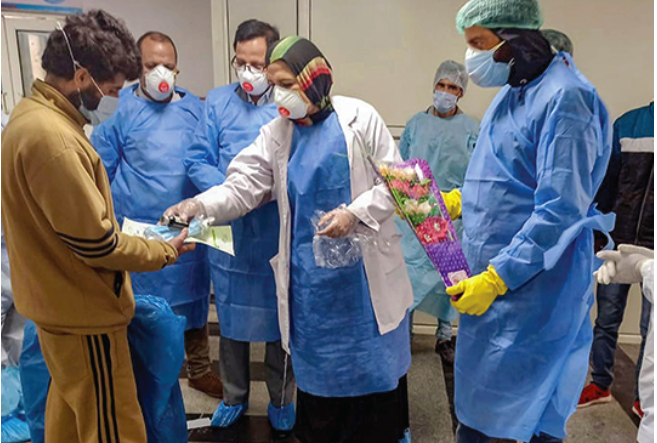As far as the coronavirus pandemic in India is concerned – we could well quote Charles Dickens’ line from A Tale of Two Cities – It was the best of times; it was the worst of times.
Indeed, ever since the coronavirus pandemic touched Indian shores, sometime around January, we have had a rollercoaster ride with infections multiplying in geometric progression by the day. Yet, it has also meant the coming together of industrialists, small-time entrepreneurs, NGOs, and individuals to strengthen the hand of the government in a full-scale fight against an unrelenting enemy, even as healthcare workers all over the country work tirelessly to heal the infected.
Chronology of a deadly spread
The very first time we heard of the Covid 19 virus was when we saw visions of people dropping off dead in the hitherto little-heard city of Wuhan in China. This was sometime in late 2019. But the full-scale of the disease dawned when nation after nation in Southeast Asia succumbed to the virus. Korea and Japan were the worst affected in the region, following China.
Soon after, international travel saw it carried to Iran, and Italy, where the death toll rapidly mounted to a point of no return. Soon, Germany, Turkey, France and Spain had got affected.
India saw its first case of coronavirus on January 30, 2020. The victim was a medical student from Kerala who was studying in Wuhan, China. But following this, there was a long hiatus, even as the student recovered and could return home. In early February, there were two more cases reported in Kerala-both of whom were students. Around the same time, a couple from Pune who had travelled to the Middle East on a package tour reported positive. Tracing those they had come in contact with revealed around 40 people from the same group were infected. Meanwhile, Delhi and Mumbai reported some cases too, all of whom had travelled abroad. Soon after, Punjab saw some cases come up. By February-end, there was a spurt of cases everywhere. By now, the situation worsened in Kerala too, with Kasargod emerging as a hot spot, with several returnees from the Gulf and other parts of the Middle East.
On March 10, India reported six new cases of COVID-19 from Maharashtra and Karnataka–two states that had so far remained untouched by the coronavirus outbreak in India. With this, the overall number of COVID-19 cases in India touched 50. All these patients had a travel history to the US or Dubai–two locations where coronavirus cases had been on a rise. Yet, in spite of government advisories being issued regularly, religious congregations, parties, celebrations continued in many parts of the country, gradually contributing to a rise. Meanwhile, a religious meet by the Tablighi Jamaat, a fringe group of Islamic preachers sounded the death knell to India’s fightback. The Jamaatis, unmindful of the fact that there was a pandemic raging, and that their invitees included several Malay and Indonesians who hailed from badly infected regions, went ahead with their meet.
By the time the Delhi administration woke up to the fact that there were 3000 people holed up in the Tablighi premises in Delhi’s Nizamuddin, the nation had a Janata curfew declared on March 25, followed by a total nationwide lockdown from March 26 to April 14. The Jamaat invitees from abroad could not leave due to India’s self-quarantine, which meant the cancellation of all international to and fro flights. However, by then, several had moved out by rail and air to other parts of the country. Some, in fact, ended up infecting many others, and spreading the infection to hitherto unaffected states such as Andhra Pradesh, Chhatisgarh, Telangana, Tamil Nadu and Bengal. A nationwide search to trace them proved infructuous, since most refused to come forth. It is in the aftermath of the Jamaat Meet that secondary infections have risen perceptibly all over India, resulting in the number of positive cases to rise above 1000.
Failings of the Indian strategy
A sad fallout of the curfew and lockdown has been the plight of daily wagers. Employers were quick to throw out all daily wagers and ask them to leave; notwithstanding the fact that many businesses rely heavily on their labour. By the time the government appeal was backed with the assurance of paying and providing food to these labourers, most had started on foot to reach their hometowns. Most states erred in not addressing the plight of these labourers, though Uddhav Thackeray and Arvind Kejriwal did try their level best to stem this by providing shelters and food to all daily wagers and migrant labourers. Here, one must commend the Pinarayi Vijayan government of Kerala in planning it out well ahead of all. Kerala prevented its “guest” labourers leaving by arranging for food and essentials in every district. This not only prevented a mad exodus, but maintained the social distancing so necessary in controlling the pandemic. The results of this are showing now, with no new cases being reported any more in the state, and the curve getting flattened for the present.
Although the government made it clear that the food sector, and the delivery of basic essentials and services would remain exempt from the lockdown and curfew, there were several cases of overzealous policemen attacking food delivery personnel, and preventing the movement of food, as in Bengal and Karnataka. Some state governments also failed to ensure movement of basic essentials, such as in Goa, leaving urban consumers high and dry. However, in Maharashtra, barring the first few days, care was taken for everything to be made available everywhere.
Communication, or the lack of it, played a huge part in all this. The failure of the state to convey the seriousness of the situation was perhaps to blame in the defiance and callousness expressed by many people in responding to the appeal for social distancing, and taking adequate measures to test themselves. It saw doctors and health workers being beaten up and attacked in Bhopal, Indore and Moradabad. In Punjab, the police had to be deployed to trace out the sick. Worse, a police party trying to break up a congregation of Nihangs in Punjab was brutally attacked, with a police officer having his arm severed. In many parts of north India, people thought nothing about playing football or cricket in the open, even as the pandemic raged through their towns and cities. The same was true of daily wagers who set out for home on foot, even while the Delhi government made arrangements for distributing food and arranging shelter for them. When questioned, they admitted that they had not known of it. One also noticed that there were no arrangements for public announcements on the matter at the Inter-State Bus Terminus( ISBT) bus stand in Delhi where daily wagers gathered in the thousands to return home.
The uneven handling of the situation by the respective state governments was appalling too. While Rajasthan arranged for free transport for its people, the UP government charged over Rs 600 per seat on its buses, with even people sitting on rooftops having to pay a small amount for being moved.
In Mumbai, too, in spite of the initiatives taken by the state government, there was a rush for trains by migrant workers on April 15, anticipating resumption of rail services.
Although the workers ultimately dispersed, the role of trouble-makers who wanted to fan the discontent was unfortunate.
The government also failed to stem the wave of communalisation and Islamophobia that emerged following the Jamaat episode; a lot of it fanned by the whataboutery indulged in by the left-wing secular media. Thankfully, saner elements from among the Muslim community put paid to this, through appeals to the Jamaatis calling on them to willingly come out and get themselves tested.
Citizens to the rescue
Notwithstanding the failings of the central and state governments, several Indians rose to the rescue. While industrialist Ratan Tata, and actors Akshay Kumar contributed huge sums to the PM Cares Fund, with Sonu Sood, Siddharth Malhotra and Sharukh Khan coming forth to feed thousands of daily wagers who had lost their livelihoods, one had many ordinary individuals taking the initiative to feed people. The shortage of PPE kits, and especially quality surgical gloves saw many small and medium enterprises (SMEs) stepping up to manufacture kits using their unused capacities to donate these to hospitals in need.
The shortage of ventilators saw industrialist Keshub Mahindra offer to manufacture them to meet the demand. Harmandir Sahib in Amritsar came forth to open its coffers for the nation; so did many others who donated substantial amounts. Many informal groups took it upon themselves to feed needy daily wagers and their families all over the country. In Kolkata, Mumbai and Pune, many came forth to serve elderly persons living on their own, to deliver essentials as the lockdown made it difficult for many to access food and necessities.
But what was most remarkable was the way innovative technology ruled the roost in such difficult times. A virus-free sanitization box that sanitizes all foodstuff in a few minutes, ventilators that are self- cleaning, and hence prevent infecting health workers when they clean up the device, improved door handles that prevent infection were some of the many innovations that emerged.
Forging ahead
As I write this, India has moved into the second phase of its lockdown period, with another two weeks extension, until May 3. The agricultural sector has been fully opened up in view of the pending rabi harvest. The IT and IT-enabled industries, government departments and food -processing industries are now functioning normally. However, transport, schools and educational institutions remain shut. So do parks, gyms, malls and entertainment. Districts are now classified as red, orange and green zones, in keeping with the extent and numbers of infected (with red marking the worst, and green the least infected areas.)
India remains under siege; but even as the numbers continue to rise nationwide, there are many who have recovered/ continue to recover. The example set forth by Kerala proves – 100 per cent literacy is as yet, our best bet to fight back unitedly against a deadly virus that spares none.


 [/column]
[/column]